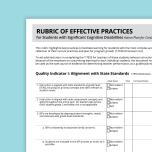Student Portfolios for Students with Complex Access Needs
In this video, Ayo Jones shares tips and strategies on student portfolios. This video aligns with the Rubric of Effective Practices Quality Indicator II: Effective Teams.
Related Content

Significant Cognitive Disabilities, Behavior, Instruction, ARD/IEP Supports, Inclusion
Rubric of Effective Practices for Students with Complex Access Needs

Significant Cognitive Disabilities, ARD/IEP Supports, Instruction, Assistive Technology, Behavior, Inclusion
Administrator Companion Document to the Rubric of Effective Practices for Students with Complex Access Needs

Significant Cognitive Disabilities, Instruction
September Monthly Instructional Guide for Students with Complex Access Needs

Significant Cognitive Disabilities
